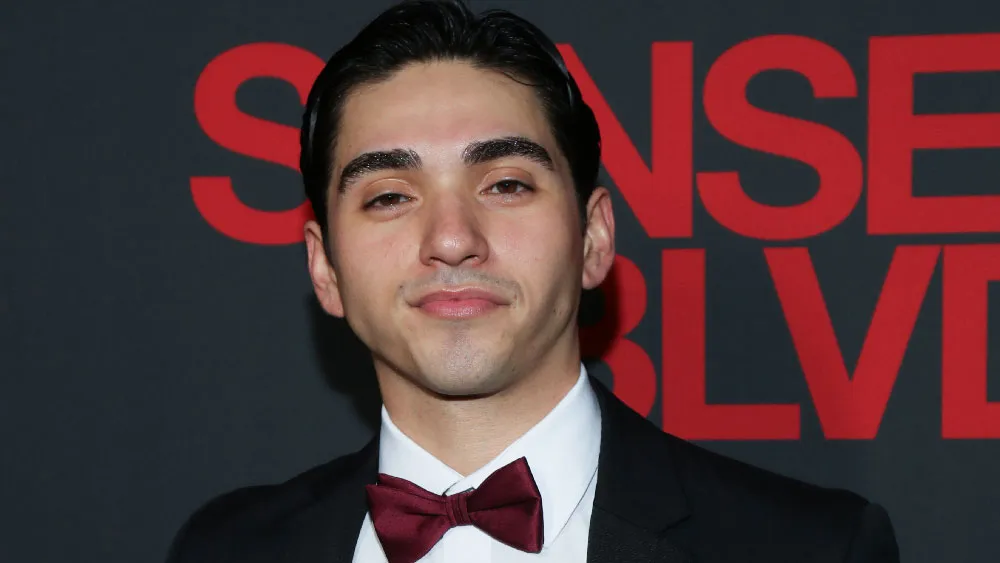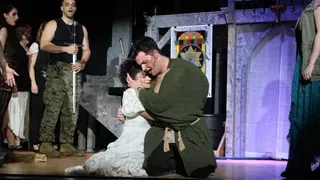March 5, 2013
Clybourne Park
Robert Nesti READ TIME: 8 MIN.
"That's nice, isn't it in a way? To know we all have a place," observes Bev, a middle-aged housewife who looks as though she walked right out of a William Inge play from the late 1950s. She throws the comment off casually, without fully realizing its impact, though it reverberates throughout "Clybourne Park," Bruce Norris's provocative play (that won the 2011 Pulitzer Prize) having its Boston premiere at the SpeakEasy Stage Company.
The person Bev is speaking of is a mentally-challenged man that works at a local grocery store, but her comment also applies to the dynamic of the social drama she and her husband - the curmudgeonly Russ - find themselves embroiled in. The time is 1959, the place the working class Chicago suburb of Clybourne Park, where the couple have lived in most of their married life, but are now moving on. They've sold their house through a local realtor; what they don't know is that the house has been sold to an inner-city African-American family, the Youngers.
If your inner theater database may have just pinged you, it because you recognize that name and the situation: the Youngers are the family from Lorraine Hansberry's epochal 1959 drama "A Raisin in the Sun," which follows the travails the family endures finding their way to 406 Clybourne Park. In Norris's canny take, they never appear in the play; but they're always present, as is the question of their race and their place in the still-heavily segregated world of Eisenhower's America.
Much of the drama of this first act, set in a house full of packing boxes, concerns just why Bev and Russ are moving in the first place, which is revealed in the act's climatic scene. It proves to be a dark secret that, if revealed, could impact the pending real estate deal. Norris doesn't rewrite Hansberry's ending, but Russ' powerful outburst does underscore the fact that prejudice extends beyond race; in other words, it takes a village to discriminate.
That village is represented by Karl, the only character common between "A Raisin in the Sun" and this play. In the earlier drama, he is the representative from the neighborhood association that tries to coerce the Youngers into not moving by paying them off. When that effort fails, Karl visits Bev and Russ and uses his trump card: he'll extort them by threatening to reveal the dark secret that haunts the couple and (it turns out) the house.
The second act moves the action up to the near past. The house - now vacant - is being sold to a prosperous white couple, Steve and Lindsey, with plans of leveling the property and building a new structure. Another neighborhood association, this one dedicated to the historical preservation of the neighborhood, objects to the design. Isn't it fifteen feet too high to conform to the zoning regulations? The objection is being brought by Lena and Kevin, an African-American couple from the neighborhood with a personal connection to the residence: She was named for her great-aunt, the matriarch who spearheaded the Youngers' move fifty years ago. The younger Lena knows the house and the history behind it.
How the argument over the demolition of the house works out brings to mind "God of Carnage," another recent play about the breakdown of civility amongst the urban gentry. Not that this one erupts into violence, but Norris does have its characters devolve into the kind of politically-incorrect humor Lisa Lampanelli excels in. As they sing in "Avenue Q": everyone is a bit racist sometimes.
What makes the play so intriguing is the way Norris parses out his narrative, from gingerly dancing around that elephant in the room (in this case racism), right down to its ghostly denouement, which ties the two acts together. He's a canny craftsman most willing to expose his characters' less-than-noble natures. Even the most sympathetic characters - Bev and Russ - are ambivalently drawn. She's a bit too 1950s stereotype; he is hardening into an angry man with whom no one wants to deal. Yet their shared pain holds the acts together.
If this couple proves, at least, sympathetic; the same can't be said for the new homeowners Steve and Lindsey, or, for that matter, Lena and Kevin. Both have their own agendas and their clash enlivens the funnier second half. "Clybourne Park" is a social satire that unfolds like a puzzle, and watching the pieces fit together gives the play its dramatic velocity.
The play, though, is one thing; the production another. It is, generally speaking, well-acted by a cast that includes any number of Boston's leading actors (Thomas Derrah and Paula Plum), plus some welcome new faces (Michael Kaye, Marvelyn McFarlane, Philana Mia, DeLance Minefee and Tim Spears). But director M. Bevin O'Gara has made crucial decisions that work against the play's sense of realism. The first is the set design (by Cristina Todesco) that places the action in a large unfinished house, with open beams suggesting (I guess) that the house is always in some phase of change. An abstraction, but one at odds with the sense of real place the title suggests. This is the kind of setting that leads you to wonder, 'if these walls could talk, what would they say?' Until you realize, there were no walls to talk. The effect is disconcerting - a design metaphor that just doesn't work.
The second is the lack of any regional dialect. This is play that takes place in a city with a most distinct accent (think Mike Ditka), yet you might think these characters live in Salt Lake City by the lack of any Midwestern inflection in their speech (most specifically in the first act - in the second, some of the characters could easily be from elsewhere). It may seem a small point, but it would be like Ben Affleck making "The Town" without Boston accents. This, and the set design, give "Clybourne Park" a remote quality that makes it difficult to latch onto emotionally.
This is unfortunate because there is fine work here by Thomas Derrah as the pained Russ and Paula Plum as his exasperated wife in the first act. Derrah beautifully conveys his hidden anger that explodes in the play's most telling scene; and with her fluttery manner and outbursts, Plum suggests that Bev would have been right at home in an Inge drama from the period. (I half-expected her to go to the door and cry out for Little Sheba.) Neither actor is used as well in the second, where they become comic caricatures, but that may well have to do with Norris's glib characterizations than their abilities.
Michael Kaye has the play's two more difficult roles: that of the neighborhood association henchman in the first act and the likeable, if arrogant home owner in the second. As his wife in both acts, Philana Mia is terrific - first as the deaf, pregnant wife in the first half; then as the self-absorbed wife in the second. Best of all is Marvelyn McFarlane and DeLance Minefee; in the first they're a black couple uncomfortably caught in the war of words (and prejudices) of the white characters; in the second, they represent the forces of neighborhood tradition, blind to the notion of progress - prejudicial, but for entirely different reasons. Filling out the cast is Tim Spears, fine in a number of roles, which includes an obsequious minister in the first half and a disengaged lawyer in the second. That he turns out to be gay only adds to the play's sly inclusionary nature.
Everyone has a place at the table - it is what Bev yearns for; but the question that "Clybourne Park" raises, with wit and some insight, is can it ever happen without friction? Norris doesn't have the answers, but his pertinent play is right on target with the question.
"Clybourne Park" continues through March 30, 2013 at the Roberts Studio Theatre, Calderwood Pavilion, Boston Center for the Arts, 539 Tremont Street, Boston, MA. For further information, visit the SpeakEasy Stage website.
Robert Nesti can be reached at [email protected].







